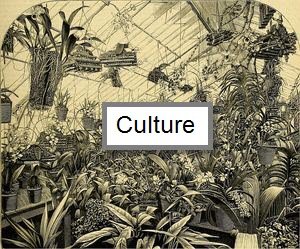Every individual adapts to a set natural environment conditions of a particular area, which in other words is called its natural habitat. When this individual is removed from its natural environment, it will always take time to adjust to those alien surroundings. Same is the case with the orchids, these can be hardy and delicate at the same time. Hardy because they can survive quite well when faced with tough conditions in their natural habitat. They are delicate because they can succumb easily to harsh conditions in environments other than their natural one.
So if you are planning to grow orchids, especially if you are a beginner, it is very important that you understand the original ecological environment and the requirements of each orchid that you grow. Orchids naturally grow on ground as well as on trees. Those growing on trees are called the Epiphytes and those which grow on the ground are the Terrestrial. Terrestrial can be lithophytes (those which grow on rocks) and saprophytes (those which grow on dead and decaying organic matter).
Each of these orchid types is adapted to a set of particular micro as well macro climatic conditions, which together constitute the natural habitat of that orchid. In case of epiphytic orchids (like Aerides, Bulbophyllums, Dendrobiums, some Cymbidiums etc.) the natural environmental conditions, especially the micro climatic conditions, existing on the tree branches are more-or-less xerophytic, with in between periods of heavy rains. The availability of water is much less as compared to the soil, even the humidity levels fluctuate and are different from those present at the ground level. The amount of sunlight available and temperature levels are decided by the type of the host tree; whether deciduous or evergreen. The availability of nutrients is also be severely restricted. So keeping all this in perspective, an epiphytic orchid develops a number of adaptive features to survive in this tough environment.
The terrestrial orchids are those which grow in the soil, on the rocks or survive on dead and decaying material found on the forest floor. Orchids which grow in the soil (like Cypripediums, Calanthe, some Cymbidiums, Phaius tankervilliae etc.) are adapted to conditions which exist in this environment.
Though lithophytic orchids have requirements different from those growing in the soil, however many orchids are seen growing both in soil as well as on the rocks. Some of these orchids are also seen growing on the trees as epiphytes. This points to the fact of how adaptable the orchids are!
Saprophytic orchids though growing in soil do not possess leaves. Most of the saprophytic orchid is underground, it only sends out flowering shoots!
Orchids grow in association with a specific type of mycorrhizal fungus. Many strains of which have been isolated by researchers. This fungus is very essential for the germination and might also assist in healthy growth of the orchid.
When you bring home an orchid always check beforehand whether it is an epiphyte or a terrestrial. They have developed specific adaptation to survive that environment only. It will perish if you force conditions other than that on it. Keep this in mind and happy orchid growing :-)

Orchid Ecology
Cultureby Anu Dharmani
Originally published in BellaOnline
Posted by Sys Admin about 9 years ago.Article Blog Article Index
Share on Social Media:
New Topics
- David George asked question Odom's Fascination - an unusual orchid in category General Discussion
- Carol Holdren asked question Grow Tent in the Garage in category General Discussion
- David George asked question rlc Caotan Beauty found at Home Depot in category Cattleya Alliance
- Kristin Dorris asked question Odontocidium Orchid fungus? in category General Discussion
- Maria Fernandez asked question Wild. Lisa Devos in category Dendrobiums
New Comments
- Carol Holdren commented on topic "rlc Caotan Beauty found at Home Depot " by David George
- Carol Holdren commented on topic "Odom's Fascination - an unusual orchid" by David George
- Dr. Florian Wolf commented on topic "Wild. Lisa Devos" by Maria Fernandez
- Michael Valcarcel commented on member plant Rlc. Chief Takanaka by Walceli Muniz Valverde
- Michael Valcarcel commented on member plant Rlc. Montana Spirit by Michael Valcarcel
- Michael Valcarcel commented on member plant Ctt. Blazing Sun by Michael Valcarcel
- Michael Valcarcel commented on member plant Bc. Spotted Clown by Michael Valcarcel
- Maria Skrypnyk commented on member plant Yamadara Redland Sunset by Maria Skrypnyk
- André Pessina commented on topic "Odontocidium Orchid fungus?" by Kristin Dorris
- Linda Hartman commented on topic "Image of a plant please" by Leshya Perkins
- Paul Reavis commented on orchid Milt. Kismet
- Christiaan Viljoen commented on member plant Psh. fragrans by Christiaan Viljoen
- Christiaan Viljoen commented on member plant Z. maculatum by Christiaan Viljoen
- Christiaan Viljoen commented on member plant C. Gaskell-Pumila 'Azure Star' by Christiaan Viljoen
- Robert H. Findlay commented on member plant Rlc. Joy Sokabe var. Volcano Queen by Sally K
- James Lunsford commented on member plant Lc. Sagarik Wax 'African Beauty AMO/AOS x Blc. Cherry Suisse'Kauai' HCC/AOS var. Cattlyea 'Hybrid ' by James Lunsford
- John Varigos commented on orchid Bulb. schwarzii
- Linda Hartman commented on topic "Issue with Blc. Ben O'Neil "Jubilee" by Glenda Ratliff
- Henry Shaw commented on member plant Ons. Catatante 'Los Roble' by Henry Shaw
- Mary Lane commented on member plant Den. Tianmu Canary by Terre Moore